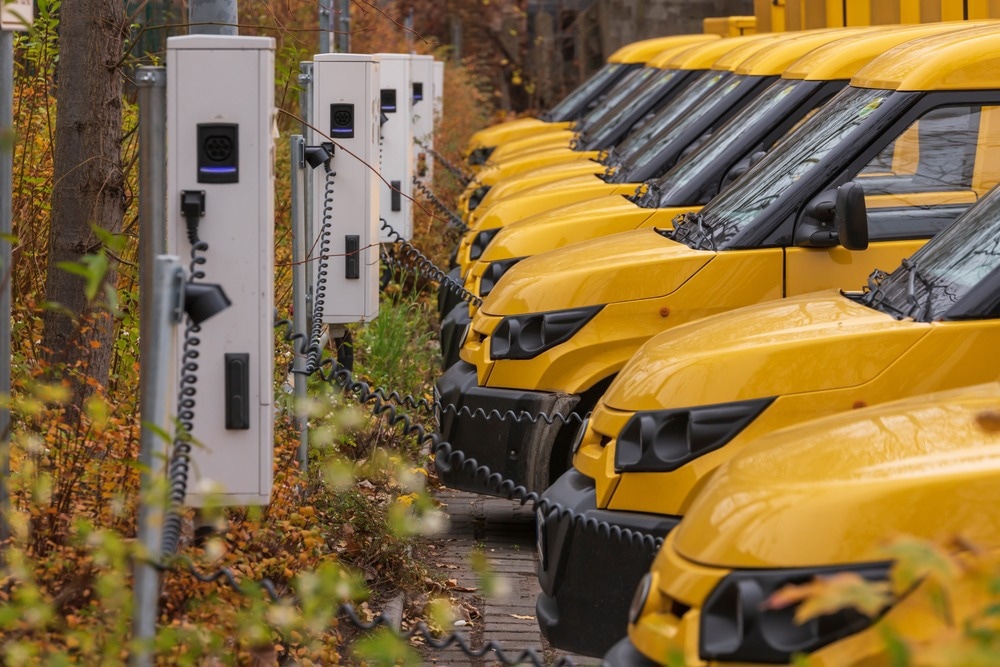Tech Mahindra launches a sports cloud platform built on AWS to provide an immersive fan experience globally
SOURCE: HTTPS://WWW.MAHINDRA.COM/
NOV 27, 2023
What Role Will The IoT Play In The Electric Vehicle Industry?
SOURCE: AZOM.COM
OCT 07, 2022

Several definitions are used in literature to define the IoT (Internet of Things). The Institute of Electrical and Electronics Engineers defines the IoT as a system of self-adaptive and complex networks interconnecting uniquely identifiable things which offer services, with or without human intervention. In recent years, the IoT is rapidly being introduced into almost all sectors, but it has particular importance in the EV industry.

Image Credit: Eakasit/Shutterstock.com
With growing environmental concerns and the depletion of fossil fuel resources, the world is searching for ways to completely replace internal combustion engines (ICE) with electric vehicles (EVs) while keeping them economical, reliable, and efficient. On a technical level, there have been considerable advancements in fundamental research on battery materials, powertrains, and control methods for EVs. However, more work must be done before EVs can be successfully commercialized, particularly in most underdeveloped nations.
When the range and charging time of electric vehicles are taken into account, a problem occurs. An electric vehicle (EV) gets charged far more slowly than a typical internal combustion engine (ICE), and even then, its range is always noticeably lower. Therefore, scientists have been working on using the IoT to solve these problems.
IoT systems are comprised of digital and physical components and are network-distributed but not always linked to the same internet devices and objects. The IoT uses intelligent physical objects, primarily electrical ones, that are network-connected and data-exchange-capable thanks to integrated software, sensors, and other technologies.
In a study from the 2022 International Conference on Advances in Computing, Communication and Applied Informatics, P. Veitrivezhen's team used IoT technology to integrate data from a power generating, storage, and supercapacitor unit to enhance regenerative braking efficacy. The findings indicated that a vehicle's range might be increased by up to 25%. However, this was only a prototype, and further optimization of the material selection might result in even more extended ranges.
This system creates electricity as soon as the vehicle continues to move, in contrast to conventional regenerative braking. The supercapacitors then temporarily store the charge created by the generator motor. The required charge is then transferred to the PSS (pass-through circuit) module and amplified before being sent to the BMS (battery monitoring circuit), which ultimately arrives at the battery.
E-mobility is adopting the IoT megatrend, which is changing transportation with battery-powered, zero-emission vehicles and networked, autonomous mobility. Electric vehicles (EVs) have a battery that needs to be recharged and supplies electricity to an electric motor. The electric powertrain (battery, converter, and traction motor), controller, onboard chargers, and charge ports are the primary electrical parts of an electric vehicle (EV).

Compilation of the top interviews, articles, and news in the last year.
The BMS's initial two primary duties are battery protection and monitoring. While the protection process is in charge of returning the system to a safe state when the observed values go over or below their safe operational ranges, the monitoring function entails measuring the battery's current, voltage, and temperature. The more recent and sophisticated BMS includes state estimation, temperature management, cell monitoring, balancing, battery safety, and protection.
Many manufacturers employ autopilot, one of the coolest IoT applications. Nissan, Tesla, Audi, and BMW are just a few examples. Previously, original equipment manufacturers like Mobileye, Delphi, and Bosch, among others, sold these components and technology to automakers. However, Tesla has since done its own research and development. As they go, these cars continue to collect data, which allows the system to be constantly improved and the company information to be up to date.
Due to IoT advances, EVs are not just limited to cars anymore. By developing electric and autonomous tractors that use electrification, automation, and artificial intelligence, John Deere hopes to change the agricultural business. Electric motors are more efficient, dependable, lightweight, and provide significant torque at low speeds.
P.L Arunkumar and his team studied the effectiveness of the battery-powered off-road industrial electric vehicle's speed control algorithm compared to the allowed operating parameters. The IoT-based intelligent microcontroller keeps track of the vehicle's parameters and makes a prioritized combinatorial decision. The findings provide information on the numerous test cases and support that the algorithm automatically lowers the vehicle speed to the recommended level with 7% variance and 93% accuracy, guaranteeing safe vehicle operation and extended battery life.

Image Credit: Ronald Rampsch/Shutterstock.com
For one month, Weihua Wu and his colleagues in Nanjing, China, used 5G technology to gather real-time data on traffic, road conditions, battery usage, and electric vehicle use. The placement of charging stations can also be chosen using this data.
Overall, this article, published in the journal Energies, gives an overview of how the IoT has been extensively employed in the EV business, from navigation to car monitoring systems, and can continue to develop this sector in the future through effective battery usage, range extension, etc.
This research is valuable for auto manufacturers who want to reduce their carbon footprint by switching to a sustainable option, and with continuous advancements in IoT systems, opportunities are unlimited.
More from AZoM: Graphene Batteries in Electric Vehicles
Tran, Manh-Kien, S. Panchal, T. D. Khang, K. Panchal, R. Fraser, and M. Fowler. (2022). Concept Review of a Cloud-Based Smart Battery Management System for Lithium-Ion Batteries: Feasibility, Logistics, and Functionality.Journal of Batteries 8, no. 2: 19. https://doi.org/10.3390/batteries8020019
Lipu, Molla Shahadat Hossain, A. Al Mamun, S. Ansari, Md. S. Miah, K.Hasan, S. T. Meraj, M. G. M. Abdolrasol, T. Rahman, Md. Hasan Maruf, M. R. Sarker, A. Aljanad, and N. M. L. Tan. (2022). Battery Management, Key Technologies, Methods, Issues, and Future Trends of Electric Vehicles: A Pathway toward Achieving Sustainable Development Goals. Journal of Batteries 8, no. 9: 119. https://doi.org/10.3390/batteries8090119
P. Vetrivezhan, B. Ojha, A. Yadav, A. Bisht, and J. Solanki,(2022). Investigation on performance of IoT integrated Accelerated Regenerative Braking system by incorporating EV Range extender. 2022 International Conference on Advances in Computing, Communication and Applied Informatics (ACCAI), 2022, pp. 1-7, https://doi.org/10.1109/ACCAI53970.2022.9752521
Wu, Weihua, Y. Zhang, D. Chun, Yu Song, L. Qing, Y. Chen, and P. Li, (2022). Research on the Operation Modes of Electric Vehicles in Association with a 5G Real-Time System of Electric Vehicle and Traffic. Journal of Energies 15, no. 12: 4316. https://doi.org/10.3390/en15124316
Arunkumar, P.L., M. Ramaswamy, and C. Sharmeela, (2022). Internet of Things Based Speed Control for an Industrial Electric Vehicle Using ARM Core. Journal of Ecological Engineering & Environmental Technology 23 no. 2: 113-121. https://doi.org/10.12912/27197050/145584
Disclaimer: The views expressed here are those of the author expressed in their private capacity and do not necessarily represent the views of AZoM.com Limited T/A AZoNetwork the owner and operator of this website. This disclaimer forms part of the Terms and conditions of use of this website.

Written by
I am a passionate researcher pursuing my Ph.D. at the University of Wollongong, Australia. I graduated with a master's degree in Mechanical engineering from the University of Engineering and Technology Taxila, Pakistan, and have worked in various manufacturing and research industries for six years. I am always keen to learn new things to broaden my horizon.
LATEST NEWS
Augmented Reality
Hi-tech smart glasses connecting rural and remote aged care residents to clinicians
NOV 20, 2023
WHAT'S TRENDING


Data Science
5 Imaginative Data Science Projects That Can Make Your Portfolio Stand Out
OCT 05, 2022

SOURCE: HTTPS://WWW.MAHINDRA.COM/
NOV 27, 2023
SOURCE: HTTPS://WWW.IOTTECHNEWS.COM/
OCT 27, 2023
SOURCE: HTTPS://WWW.THEDAILYSTAR.NET/CAMPUS/
OCT 01, 2023
SOURCE: HTTPS://WWW.IOTFORALL.COM/
SEP 11, 2023
SOURCE: HTTPS://WWW.IOTTECHNEWS.COM/
AUG 10, 2023
SOURCE: HTTPS://WWW.SCIENCEDAILY.COM/
AUG 11, 2023